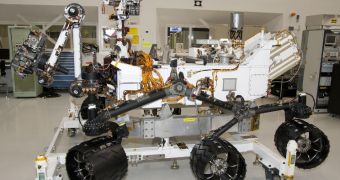Officials with the American space agency are proud to announce that the next rover to be sent on Mars is now nearing completion at a NASA integration facility. The robot is now almost done, having already undergone a massive number of tests to assess its performances.
Little by little, engineers have brought the Mars Science Laboratory (MSL) to the rough appearance that it will have when it will be conducting its investigations on the surface of the Red Planet.
The assembling and testing stages of the mission are going smoothly, in anticipation for a launch date this winter. NASA estimates that an opportunity window will open for the rover – now called Curiosity – between November 25 and December 18.
If this window can be exploited, then the robotic explorer could reach its intended target around August 2012, when it also starts its scientific investigations. The MSL is the largest, heaviest and most complex machine ever to be sent into space.
At this point, engineers with the NASA Jet Propulsion Laboratory (JPL), in Pasadena, California, are continuing to integrate the rover and conduct additional tests. They are assessing the functionality of both the explorer itself, and of components that will be alongside it to Mars.
The JPL is managed by the California Institute of Technology (Caltech), also in Pasadena. The Lab in turn manages the MSL mission for the NASA Science Mission Directorate, in Washington, DC.
Current plans call for Curiosity and related components to be delivered to Florida between May and June. Final preparations for flight will be conducted at the NASA Kennedy Space Center (KSC).
In the mean time, experts still have to decide where they will land the massive, 1-ton machine. Four spots are now the final candidates, and a workshop that will take place soon will finally determine which one of them will receive Curiosity.
Each of the locations has its own benefits and drawbacks, but on the other hand they were selected from tens of other proposals. This means that the MSL mission will most likely return equally relevant results from all of them.
Curiosity's main goal is astrobiology research. It will search for signs of present or past life on the Red Planet, by conducting analysis of soils samples inside its internal ovens. It will also be able to conduct remote investigations of interesting rocks and other structures.
MSL is powered by a nuclear engine, and will be delivered by the innovative, yet never-before-tested Sky Crane system. The rover is about the size of a Mini Cooper, and is expected to give scientists a new insight into our neighboring planet.

 14 DAY TRIAL //
14 DAY TRIAL //